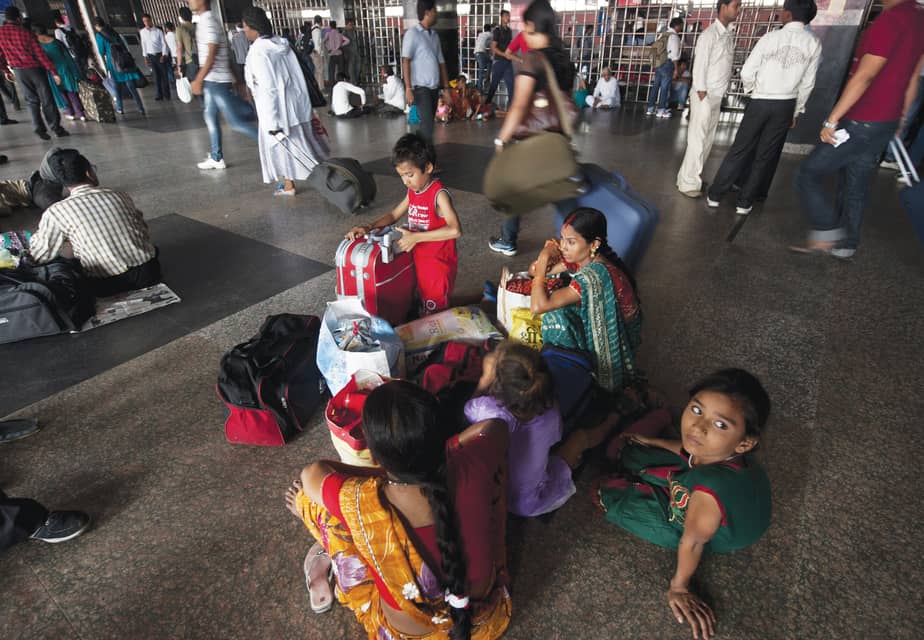At Delhi’s busy railway stations, child traffickers use every trick up their sleeve to evade detection, but social workers are close at their heels
A sea of people, some making their way to trains, some getting off, others waiting, occupying every inch of space on the platforms. This is a common feature in Delhi’s train stations and especially the New Delhi one, which sees at least 400 trains pass through, originate or terminate.
And in this milieu of utter chaos are social workers looking out to help children, most cases being of child labour and of runaway kids. The team of non-profit ChildLine walk around looking for any child that looks suspiciously alone, or is accompanied by suspicious persons.
The NGO also has informants spread out – porters, vendors and autowallahs. This has been done by networking with them, not sitting in an office. In fact, their office space is inconspicuous, in the unlikeliest corner of the busy railway station.
As we witness the team’s routine – porters nudging past us with luggage and men with trollies full of supplies, both aiming for the Rajdhani Express – they spot two young boys. The boys say they are being taken back home to Bihar by an unknown youngster. This statement obviously makes the team wary for they have intercepted many children who are returning after working at sweatshops in Delhi or as domestic workers.
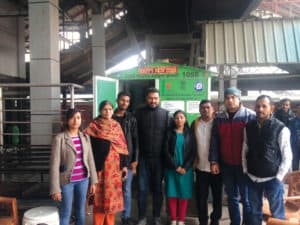
Any child below the age of 14 who is found working becomes a case of bonded labour. The usual modus operandi of traffickers is to pay some amount of money to the family of the victim and none to the child. The child thus becomes totally dependent on the employer for food and other needs.
“When we observe children of the same age coming in groups, we go and screen them. It usually turns out to be a case of child labour”, says Junaid Khan, coordinator of ChildLine’s work at the New Delhi railway station. What has changed, making their work even more difficult, is children coming individually. “Traffickers give the family an advance of Rs 20,000”, and then they are made to drop off the child in Delhi.
Even after a rescue, when they are taken to the Child Welfare Committee, the parents are called and the child goes away with them, only to be put back to work in the factory, Khan points out.
The children usually come from Bihar and Jharkhand. From the former, Khan says, boys are brought to work in the shoe, bags and bangle making factories of Delhi. These are located in Jahangir Puri, Sadar Bazar, Inderlok, Nabikarim and Kashabpura areas of Delhi.
Another ChildLine member Rajveer Chauhan tells us that a visit to Nabikarim is enough to find out that underage children are working at the site. “Police know about it, and the government as well but nothing is being done”. Another adds that the Railway Police Force and the Government Railway Police take it as secondary work, “even when we take the children to hospitals for assessment, the staff don’t take it seriously”.
The other state, Jharkhand, has girls coming in to the Capital for domestic work. Khan points to unregistered placement agencies being the link. The kids are then open to abuse.
Last year these placement agencies came into the spotlight after at least three cases of abuse by agents and the employer, of delay in wages and no freedom of movement came to the forefront.
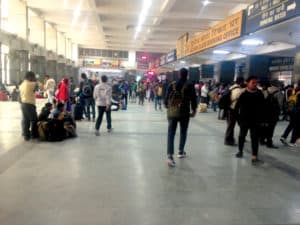
The team here has been able to make a list of vulnerable trains — ones that come from states with the most incidents of trafficking and children running away.
When ChildLine’s work begun in 2015 in the railway stations, the few trains mapped were usually those coming from Bihar and Bengal. In course of time, the activity was shifted to Anand Vihar station — where there’s another team manning the ground.
Last month they encountered 16-17 cases, says Ruby Sharma, a team member. She adds that what makes their work even more difficult are children who are fed lies to tell in such a situation. “We have to counsel them for hours and then they open up and tell us the truth”, she says.
The team notices everything, from how confident the child looks, to who they are with, and what they are wearing or not wearing. Earlier those trafficked would be without slippers, now they have to keep a watch for those with new shoes and clothes.
But even when approached, they are faced with a different challenge. It is difficult to ask questions in the face of fake Aadhaar cards which declare the minors to be adults.
Identity problems
Recently, three girls from Assam were rescued by the ChildLine staff at the station. By appearance, they clearly were not 18, Chauhan says, but the Aadhaar cards stated they were. And as they said they had come of their own free will, they were allowed to leave. “For social workers, it’s very saddening to see such effort go to waste. And we are unable to help the child”, he adds.
Furthermore, he says government related institutions looking into child rights had said they would install scanners to check the Aadhaar card “but currently there’s no such system”, and so they have to run to UIDAI headquarters to check the documents.
Some team members sullenly add that the police know about all that is happening, but child labour is not taken seriously. “We have had incidents when a case is brought to the station police’s notice, they look at us and say that even the children have to earn a living”.
And the glaring fact is that many families are unable to support their children, let alone themselves, which can be seen with the government’s figures on those living below poverty line.
In Bihar, the total percentage of people living below the poverty line is a high 41.4, Jharkhand has 40.3%. The two states are only topped by Odisha with 46.4% — the biggest source state for adult bonded labour.
Search for solutions
Since there is a high incidence of bonded labour in these states, monitoring should be done at the village level, says Khan. “The panchayat should be involved to see where people are going. Only then can this situation be brought under control”. He also points to a serious lack of inter-state coordination.
On ChildLine’s wish list is a mechanism whereby once a child is rescued and sent back to his home state, the state in question tracks the child and sees to his well-being.
Information should also be put online in the form of a national database, Khan says, so that when the CWC is approached, they can check out actual details of a child rescued.
Another time, another place
When one thinks about trafficking via trains, we envisage a sleeper class with women, men and children. And the traffickers know exactly how we think. Which is why, the preferred class of transport is AC carriages.
This is a phenomenon that the team handling the rescues at the Old Delhi railway station – the oldest lifeline connecting the country, built in 1864 – tells us about.
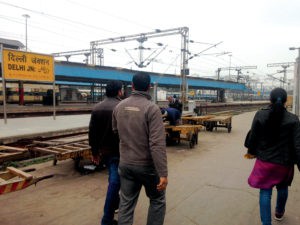
Here the team consist of 19 members, with 6-7 present at all times doing outreach work. This means scanning the station and trains – generally it will be two from the group. One goes inside the train while the other remains outside matching the steps of his/her team member.
Also, out of these 19 there are three members stationed at Shahdara railway station keeping an eye out for those stealthy traffickers who alight before reaching the major stations where they know Childline could be waiting to bring them to justice.
At this end of Delhi, the majority of cases come from Assam, Uttar Pradesh, Bihar and Jharkhand, with most being runaways. These children are either victims of some form of abuse or are attracted by the bright lights — and prospects — of the city.
They are vulnerable to a host of ills, including becoming part of groups of other children around the station who do drugs, besides being abused and trafficked.
The social workers tell us about their network of stakeholders, from the ticket checker on the train to other train staff who have been guided on the steps to help such children. They also work with the Railway police and the regular police force which informs the team whenever they see a child who is alone or in any other suspicious circumstances.
National nexus
Mohd Hussain, senior team member at Salaam Baalak Trust, has been working for child rights for the past nine years. His day starts with coming to the office provided at Old Delhi railway station – a proper one unlike the New Delhi unit – to join forces with another team member and head out to look for distressed children.
The teams find at least 80 children during their outreach in a month. In February, they have rescued 25.
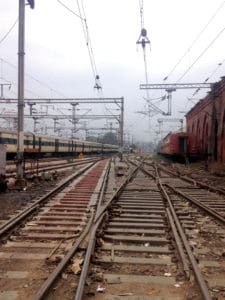
“Some children are trafficked and taken for domestic house work,” says Rashid Riaz, a senior coordinator. He tells us about a case of a girl who had been brought to Delhi from the Morani village of Assam. She spent her days working in a tea garden before being recruited by a girl from her own village who was 20 years old and had been working in Delhi.
This is what the traffickers look for. A person who will work on their behalf, becoming traffickers themselves at village levels. In this case, the girls in question had been asked to bring more girls into Delhi.
This can also be seen in the level of trafficking for adult bonded labour, where a dozen people might be recruited from the same village.
Shijan Thomas, senior coordinator of the programme points to a “big nexus” of traffickers. “The recruiter does not work directly. Instead, he appoints district-wise agents who work for them.”
But in such cases, he says, proving trafficking is very hard. “The child does not speak or reveal the truth. They change their statements”, and thus they have to let people go sometimes.”
The Trafficking of Persons (Prevention, Protection and Rehabilitation) Bill, 2018 which was passed in the Lok Sabha, awaits approval by the Rajya Sabha. The bill deals with a very important aspect which emerges from the current patterns, of the setting up of authorities at the district, state and national levels for rescue of trafficked persons and investigation of offences.
According to the National Crime Records Bureau, a total of 8,132 cases of human trafficking were reported in India in 2016, a 15% increase from 2015. In 2016, a total of 23,117 trafficking victims were rescued. Of these, the highest number of persons were trafficked for forced labour (45.5%), followed by prostitution (21.5%).
This report is part of NFI’s National Media Award Programme
TRAINS MAPPED
In the New Delhi railway station the vulnerable trains are Swatantra Senani train from Bihar. Sampurn Krant which brings in many kids for child labour. Then there’s Purva express, Magat express and Silchar to new delhi Express.
In the Old Delhi railway station, the vulnerable trains are the Brahmaputra Express, Bihar Sampark Kranti, Farakka Express, Kaifiyat Express, Ashram Express and Amrapali Express.

